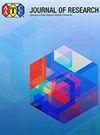Preparation of Highly Effective Antibacterial Cotton Fabrics Based on Bifunctional Reactive N-Halamine
IF 1.2
4区 工程技术
Q4 MATERIALS SCIENCE, TEXTILES
引用次数: 0
Abstract
Two novel halogenated triazine amine N-halamine antimicrobial precursors, sulfuric acid mono-(2-{4-[4-chloro-6-(2,2,6,6-tetramethyl-piperidin-4-yloxy)-[1,3,5]triazin-2-ylamino]-benzenesulfonyl}-ethyl) ester sodium (PT) and sulfuric acid mono-(2-{4-[4-(3-pyridinecarboxylic sodium)-6-(2,2,6,6-tetramethyl-piperidin-4-yloxy)-[1,3,5]triazin-2-ylamino]-benzenesulfonyl}-ethyl) ester sodium (CPT), were designed, synthesized, and applied onto cotton fabrics to obtain antibacterial properties. The molecular structures of PT and CPT contained two reactive groups of vinyl sulfone and nicotinic acid, which increased the reaction with cotton fabrics compared with other antibacterial agents. The dyeing process of reactive dye was selected as the finishing method due to the similar structures of antibacterial agents to bifunctional group reactive dyes. The treated cotton fabrics were chlorinated with sodium hypochlorite to obtain antibacterial functionality. The chlorinated fabrics achieved outstanding antibacterial properties against Escherichia coli O157:H7 and Staphylococcus aureus with short contact time. Moreover, the stability measurement exhibited that the chlorine on the samples could be repaired by the diluted sodium hypochlorite solution after washing and long-time storage. In addition, the mild low-temperature process reduced fabric damage, and only about 10% and 15% of the original tensile strength was missing after finishing and chlorination in both the warp and weft directions. Compared to the traditional pad–dry–cure technique, the process developed of antimicrobial cotton had some advantages such as low salt, energy savings, and maintaining tensile strength.基于双官能团N-Halamine的高效抗菌棉织物制备
设计合成了两种新型卤化三嗪胺n-卤胺抗菌前体硫酸单-(2-{4-[4-氯-6-(2,2,6,6-四甲基哌啶-4-乙氧基)-[1,3,5]三嗪-2-氨基]-苯磺酰基}乙基)酯钠(PT)和硫酸单-(2-{4-[4-(3-吡啶甲酸钠)-6-(2,2,6,6-四甲基哌啶-4-乙氧基)-[1,3,5]三嗪-2-氨基]-苯磺酰基}乙基)酯钠(CPT),并将其应用于棉织物上,获得了抗菌性能。PT和CPT的分子结构中含有乙烯砜和烟酸两个反应基团,与其他抗菌剂相比,增加了与棉织物的反应。由于抗菌剂与双官能团活性染料结构相似,选择活性染料染色工艺作为整理方法。用次氯酸钠对处理后的棉织物进行氯化处理,获得抗菌功能。氯代织物对大肠杆菌O157:H7和金黄色葡萄球菌的抗菌性能优异,接触时间短。此外,稳定性测试表明,经过洗涤和长期存放后,稀释的次氯酸钠溶液可以修复样品上的氯。此外,温和的低温处理减少了织物的损伤,经纬方向经整理和氯化处理后,织物的原始抗拉强度仅损失10%和15%左右。与传统的棉垫-干固化工艺相比,抗菌棉工艺具有低盐、节能和保持抗拉强度等优点。
本文章由计算机程序翻译,如有差异,请以英文原文为准。
求助全文
约1分钟内获得全文
求助全文
来源期刊

AATCC Journal of Research
MATERIALS SCIENCE, TEXTILES-
CiteScore
1.30
自引率
0.00%
发文量
34
期刊介绍:
AATCC Journal of Research. This textile research journal has a broad scope: from advanced materials, fibers, and textile and polymer chemistry, to color science, apparel design, and sustainability.
Now indexed by Science Citation Index Extended (SCIE) and discoverable in the Clarivate Analytics Web of Science Core Collection! The Journal’s impact factor is available in Journal Citation Reports.
 求助内容:
求助内容: 应助结果提醒方式:
应助结果提醒方式:


